Tennessee Reclamation Project
More Lessons Learned for the New Millennium
written by Patricia Clark
UT soil scientists are helping to reclaim the last of an area laid waste by mining and smelting operations that date back 100 years.
Imagine dust and desolation as far as your eyes can see. Now try to convince yourself that you're standing in southeast Tennessee. Sixty years ago, nearly 36 square miles of the hills surrounding Ducktown in Polk County were devoid of vegetation. Known as Copperhill, the region, which included parts of Fannin County, Georgia, and Cherokee County, North Carolina, was famous for its environmental degradation.
Nearly one hundred years of copper mining and ore smelting had totally stripped some 23,000 acres, and another 9,000 acres a total of 50 square miles ? had been impacted by the mining. The most intensive mining occurred after 1891, when the North Georgia Railroad was completed through the area.
Roads were cleared for the mines. Forests were denuded to provide fuel for the smelting, and the smelting itself caused very acid rain to fall on the hills, killing vegetation and fouling streams and ponds.
Today, after 60 years of work by the Tennessee Valley Authority, landowners, and public interest groups, millions of trees have been planted and much of the area is undergoing a slow renovation governed by Mother Nature's steady hand. Although mining operations ceased in 1987, 350 acres of the area have defied remediation. They remain totally bare.
Tom Ammons, a professor of soil science with the University of Tennessee Institute of Agriculture, knows why. With a $215,000 grant from the present owners of the property, Glenn Springs, Inc., Ammons and a team of other researchers with the Tennessee Agricultural Experiment Station are developing and testing plans for the final remediation of the Copper Basin.
A Fixable Mess
The acres that remain bare are the dry tailings ponds for the former mining and smelting operations. Tailings are the waste products of these operations. During the mines' heyday, impure ore was ground to a powder and added to water. Minerals of value tended to float in the resulting slurry and were then skimmed from the top for further processing. The remaining sludge was stored in the tailings ponds.
Over the years, the moisture in the tailings ponds evaporated, leaving behind the bare pond bottoms and, curiously, five wetlands around the fringe. On the day of our visit, a Canada goose was leisurely swimming among the cattails in the largest of the wetland ponds.
The wetlands developed naturally amidst the degradation, and are an oddity to the scientists. Ammons and Vanessa Stevens, a UT research assistant, are measuring and monitoring the physical properties of the wetlands, especially the naturally formed hydric soils. They want to understand how such moist soils essential to the delicate and environmentally important wetlands formed at the edge of a wasteland.
Franklin Miller, Glenn Springs' vice president for operations, says Glenn Springs is concerned with the maintenance of the wetlands. They've even constructed artificial wetlands as a means of understanding the naturally formed sites. "We don't want anything we do to contaminate our wetlands," he says.
As for the former tailings pond, its ground is composed of crushed waste materials and has the consistency of sand. Before his testing began, Ammons expected to find the bare acres seriously contaminated with heavy metals and other biohazards, particularly pyrite, an extremely acidic compound often extracted from unrefined copper ore. "We were surprised to find that was not the case," he explained as we walked across the exposed soil. "We tested the soil to two meters deep ? no heavy metals. The problem is no phosphorus."
Phosphorus is an essential nutrient for plants and is a common ingredient in fertilizers. Waving his arm across the stark panorama, Ammons proclaimed, "The site's a mess, but it's a fixable mess."
A Remediation Plan
Working with a team of UTIA scientists and graduate students, Ammons has developed a plan to make the area inhabitable and useful. The first phase began with the seeding of a mixture of grasses and legumes in September 1998. A second seeding occurred in March 1999. Once vegetation is established on experimental plots, Ammons is confident that "the vegetation recipe" can be applied throughout the devastated area.
Graduate student Thomas Cook helped to determine what would be used to establish two, one-acre experimental plots. "We chose plants that had been successful with coal mine reclamation. I sowed four mixtures of grasses and legumes and applied one of four phosphorus treatments to comparative plots marked out on a grid on the acre." One of the treatments was a control treatment in which no phosphorus was applied, Cook explained. David Walker,
UT research assistant, helped Cook establish and sample the plots. As a bonus to the remediation study, Ammons and Cook are studying the effects of using bio solids as a fertilizer. Bio solids, including wastes from animal operations such as poultry farms and sludge from human waste treatment plants, are becoming a disposal problem across the country. The researchers are comparing the performance of the grass/legume mixtures fertilized with bio solids to those fertilized with conventional agricultural chemicals. They obtained more than 27,000 pounds of treated sludge from Chattanooga's Moccasin Bend Waste Treatment Facility for the study. Treated sludge have had contaminants such as E. Coli and Cryptosporidium removed.
Some of the experimental treatments have proved successful, despite drought and problems with wind erosion. "The wind picks up tiny particles of soil and blows it across the site," said Ammons. "The particles just cut down young seedlings, so we erected a silt fence to deter that." By the beginning of the summer "local" plants had invaded the site. Animals, too, were beginning to check out the new habitat. Both a rabbit and a toad had been spotted.
As the first year of the experiment drew to a close, the bio solids treatment proved to be the most successful with plantings of grasses, but legumes performed better on the treatments that did not incorporate bio solids Both treatments showed tremendous potential for vegetative growth where none had previously survived.
The Next Step
Ammons will monitor the experimental plots and wetlands for at least another year, then he will develop a revegetation plan for the whole 350 acres. Long-range plans for the basin depend upon total remediation, and before plans can be drawn, Ammons' team will need to completely inventory the elements contained in the disturbed soils. Janice Branson, a post-doctoral research associate, is working with Robert Freeland, an Experiment Station associate professor and agricultural and bio systems engineer, on mapping the soils and monitoring the watershed with ground-penetrating radar.
The benefits of the project reach far beyond East Tennessee. The results of this effort may be useful in the reclamation of other mining sites across the country and around the world. Glenn Springs' parent company, Occidental Petroleum, has holdings of disturbed soils in Wyoming, Utah, and Australia, and the hope is that the techniques being developed and tested in the Copper Basin will be applicable to the remediation of other sites.
Miller has worked to compile the remediation information available from previous Copper Basin projects conducted by TVA and others. "We're building a pretty sustainable database. It's a work in progress, but the data spans 50 years," he said.
With the addition of Ammons' results, future reclamation attempts may be more successful in a smaller time frame. If so, the barren hills of Copper Basin and other mining sites scattered around the globe may become mere memories and "lessons learned" from the second millennium.
written by Patricia Clark
contact information:
Dr. J. Thomas Ammons, 865-974-8804;
Patricia Clark, 865-974-7375
University of Tennessee Agricultural Experiment Station
Pictorial of Work on the Reclamation Project
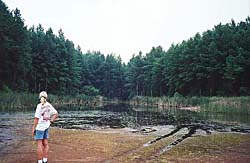 |
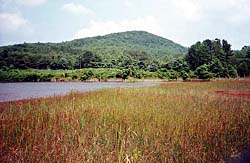 |
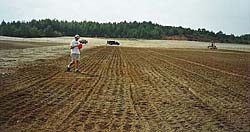 |
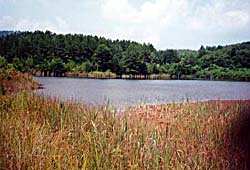 |
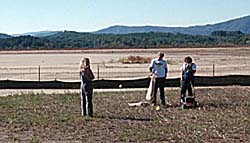 |
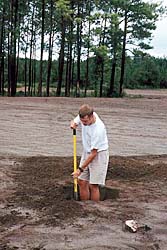 |
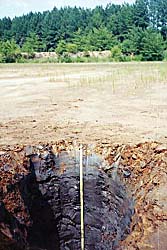 |
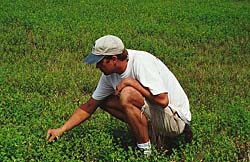 |
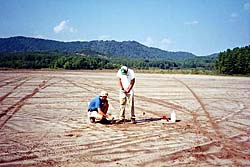 |
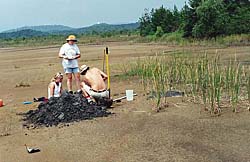 |
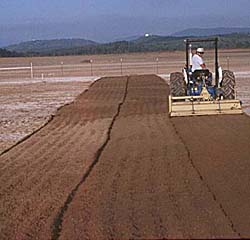 |
![]()
Sign
up for the Blue Ridge Highlander Newsletter, Messages from the Mountains
to find out first about our new feature stories, road trips and special offers
Your e-mail addresses will not be sold or given away to anyone.
Privacy
Policy
Interested in your business being on the Highlander, click here...
Let our visitors tell you about the Highlander...
Click the feathers to go to the Highlander site
map...

